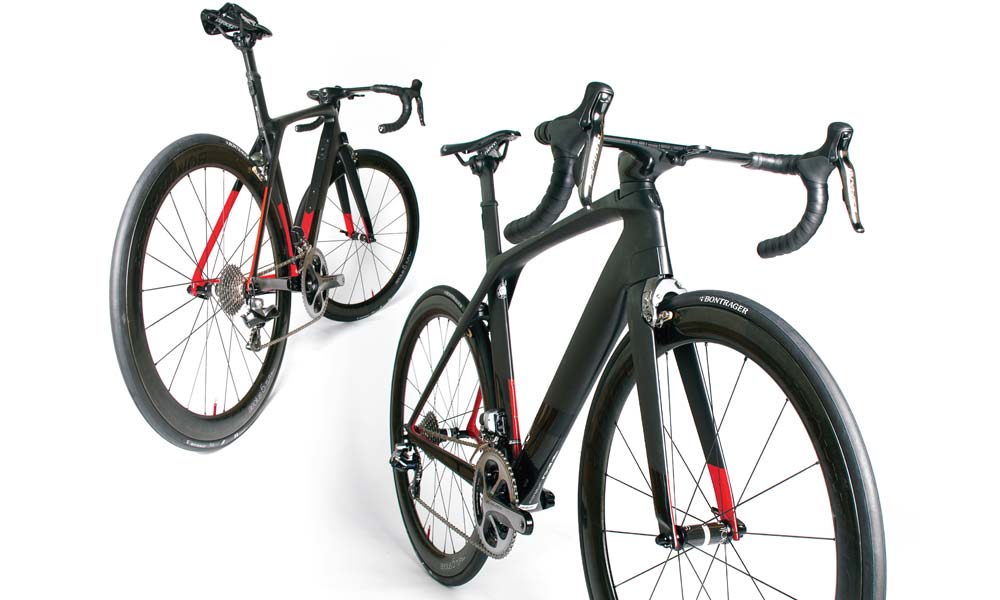[et_pb_section bb_built=”1″ admin_label=”section”][et_pb_row admin_label=”row”][et_pb_column type=”1_4″][et_pb_text background_layout=”light” use_border_color=”off” border_color=”#ffffff” border_style=”solid” _builder_version=”3.0.93″]
The Trek Madone was completely reinvented in 2015. You can find the full review and build report online now as it appeared in the magazine…
[/et_pb_text][/et_pb_column][et_pb_column type=”3_4″][et_pb_text background_layout=”light” use_border_color=”off” border_color=”#ffffff” border_style=”solid” _builder_version=”3.0.93″]
RIDE Media reviewed numerous Trek Madone bikes over the years and it has been interesting to watch the evolution of this lightweight race bike. In 2015 it was entirely revamped with aero inclusions and the famous decoupler at the seat tube/top tube junction to assist with comfort.
– Read the full review as it appeared in the magazine. –
“Perhaps the most impressive aspect of this new Trek is its comfort. It has a Domane-style decoupler fitted in the seat tube which allows a small amount of flex in the seat mast. It is barely noticeable on short rides but after a lengthy stint in the saddle, it was clear to me that this feature is doing its job.
“Riding over 100km per day for three days in a row was as good a test as any and my back, bum and shoulders felt no stress from the previous day’s activity. When comparing to other ‘race’ orientated bikes, the Madone stands head and shoulders above in the plush competition.”
[/et_pb_text][/et_pb_column][/et_pb_row][et_pb_row][et_pb_column type=”4_4″][et_pb_image show_in_lightbox=”off” url_new_window=”on” use_overlay=”off” animation=”left” sticky=”off” align=”left” force_fullwidth=”off” always_center_on_mobile=”on” use_border_color=”off” border_color=”#ffffff” border_style=”solid” _builder_version=”3.0.93″ src=”https://www.ridemedia.com.au/wp-content/uploads/2018/02/RIDE70-TrekMadone-WEB.jpg” url=”https://indd.adobe.com/view/284ec146-50d1-4c88-866f-381bbc66a9b8″ show_bottom_space=”on” /][/et_pb_column][/et_pb_row][et_pb_row][et_pb_column type=”1_4″][et_pb_text background_layout=”light” use_border_color=”off” border_color=”#ffffff” border_style=”solid” _builder_version=”3.0.93″]
Click the image above to see the Trek Madone 9.9 review as it appeared in our magazine (published November 2015).
[/et_pb_text][/et_pb_column][et_pb_column type=”3_4″][et_pb_text background_layout=”light” use_border_color=”off” border_color=”#ffffff” border_style=”solid” _builder_version=”3.0.93″]
Built report in brief
The ‘Control Centre’ is situated at the top of the down tube and it is pure genius. It houses the battery and the main junction box. It has a quick-release tab so the j-box can be removed and charged easily.
The brilliance of this design is a five-port junction box rather than a three port box, meaning that there does not have to be another j-box inside the frame. All the cables meet at the control centre and this makes diagnostics and installation simple.
For a mechanical bike, the control centre has an adjuster barrel for the front derailleur but it seems as though this bike has been designed purely with Di2 in mind…
[/et_pb_text][/et_pb_column][/et_pb_row][/et_pb_section]



